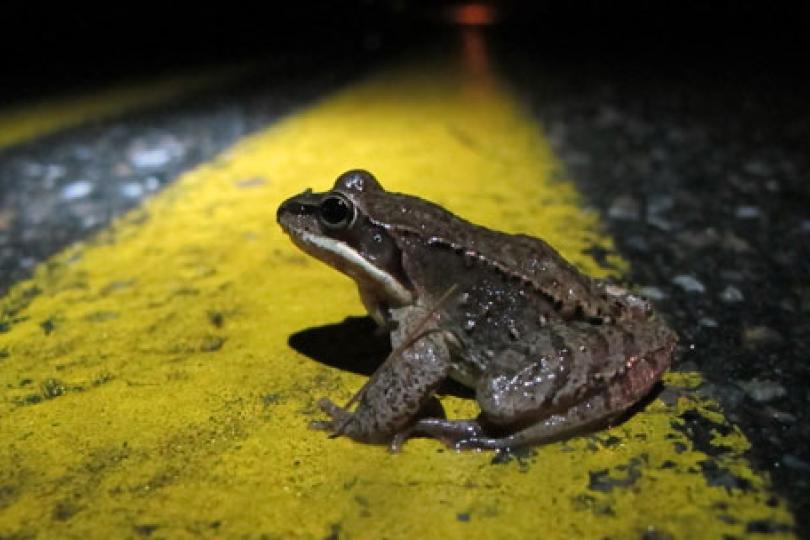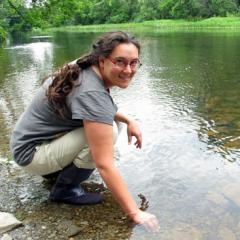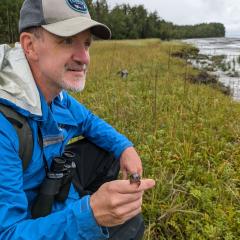5 Things We've Learned About Addressing Amphibian Road Mortality
In 2014, we received a Network Innovation grant to support a small project aimed at piloting field techniques for assessing the effectiveness of amphibian road crossing brigades, and at convening potential collaborators for a larger regional research initiative focused on reducing amphibian road mortality in the northeastern United States. Here is some of what we’ve learned from this project:
1. Pitfall trap arrays are not well-suited to New England roadsides in the early spring.
To begin assessing the effectiveness of volunteer amphibian road crossing brigades, we installed and monitored a pilot pitfall array – comprised of silt fencing and aluminum can “traps” – at an existing amphibian road crossing site in southwestern New Hampshire. A full report from this study is available here (PDF, 1 MB), and you can view photos from the project in this Flickr album. For just the highlights, read on:
Our original plan for the pitfall array, which was based on other amphibian studies conducted in natural settings, was to install the array in early spring, prior to any amphibian movement. The idea was that all amphibians that successfully migrated across the road would encounter the fence, walk along it looking for an opening, and eventually fall into a trap, where they would stay until they could be recorded and released on the other side of the fence. In this way, we could compare the number of amphibians that were carried across the road by our volunteers to the number of amphibians that successfully crossed the road on their own.
However, the persistence of frozen ground along the road edge long after adjacent forest soils had thawed – a consequence of ice compaction caused by wintertime snow plowing – prevented us from installing the array in time for the first amphibian migration of the season. In addition, rocky roadside fill made it impossible to dig the fence in along the entire length of the crossing, leaving a gap through which some amphibians crossed without ever encountering our traps. These physical and temporal gaps in the fence resulted, unfortunately, in gaps in our data. Creative thinking will be required for future efforts, either to re-design the traditional pitfall array model or to develop different survey methods for use in icy, rocky New England road corridors.
2. Amphibian crossing brigades may make a difference, at least at one site.
Because of the unexpected challenges with our pitfall array, we must exercise considerable caution when interpreting our data. With that said, we did record 1,963 amphibians crossing or attempting to cross the road at our field site in the spring of 2014. This figure includes 1,536 live amphibians that were moved across the road by more than 20 crossing brigade volunteers over the course of 8 evenings, as well as 263 road-killed amphibians. (The road-kill count is likely an underestimate, as our volunteers were largely focused on live animals and the dead were scavenged and/or pulverized beyond recognition by passing cars rather quickly.)
Thus, approximately 90% of the recorded amphibians who successfully crossed the road at this site in 2014 were moved across by our amphibian brigade volunteers. Surely, many more amphibians crossed on their own and were not captured in the traps (in other words: the total number of recorded amphibians is likely an underestimate of the actual population using the road, and therefore the percentage crossed by our volunteers is likely an overestimate), but it appears that the crossing brigades may indeed be making a difference at this site.
It is important to note that weather plays a major role in this dynamic: amphibian migrations are highly weather-dependent events, so the timing of the migration can vary greatly from year to year. In the spring of 2014, most of the season’s warm rains occurred before midnight, when volunteers were awake and therefore more likely to assist with the crossings. During other years, the warm rains that spur amphibian migrations may occur in the middle of the night, when many of our volunteers are sleeping; at those times, most of the amphibians that successfully cross the road likely do so without the assistance of the salamander brigades. Because of this variability, it would take many years of data to understand the true long-term effectiveness of crossing brigade efforts, but – given the labor intensiveness and limitations of installing pitfall arrays along New England roadsides in early spring – it may be impractical to expand the project.
3. Photo mark-recapture holds promise for citizen science.
As a side project, we photographed the spot patterns of spotted salamanders encountered at our field site – both in the pitfall array and by our crossing brigade volunteers – and were able to identify five individual salamanders on both their inbound and outbound migrations by their unique spot patterns. Documenting spotted salamander spot patterns won’t provide the same level of in-depth data that you’d get from a pitfall array, but it does have the potential for providing meaningful information on year-to-year survival in spotted salamander populations that must cross roads to reach their breeding pools. It’s also a great fit for citizen science: simple, accessible, engaging and, as one of our volunteers remarked, “way cool.” We hope to expand this initiative to more amphibian road crossing sites in the spring of 2015.
4. We need an app for that!
In the course of our work and discussions with collaborators, it has become clear that there is a strong need for (1) standardized guidelines for regional reporting of amphibian crossing data, to ensure that data are comparable from site to site and usable for statistical modeling, and (2) an app, so that volunteers can easily contribute real-time data and photos to a centralized database. We investigated whether iNaturalist.org – which can be accessed via both desktop and mobile app platforms – might meet both of these needs, but ultimately determined that the iNaturalist framework was not a good fit. We hope to work with a small group of partners to develop simple, standardized data collection protocols for amphibian road crossings in 2015, and to investigate what it would take to create our own app for collecting amphibian road crossing data.
5. A lot of you want to work towards reducing amphibian road mortality.
In the last year, we’ve corresponded with more than 40 herpetologists, road ecologists, biologists, Switzer Fellows, and citizen science practitioners, all of whom expressed great enthusiasm for taking a more coordinated, cohesive approach to addressing amphibian road mortality in the northeastern U.S. Fifteen people offered datasets to us for use in statistical modeling focused on predicting amphibian migration events, and nearly a dozen offered to serve as partners or advisors. It will take time to sort through all the data, and to assess how and if these diverse datasets – which cover a range of focal species and geographies, as well as differing environmental and temporal variables – can best be incorporated into statistical models, but we are extremely heartened by the enthusiastic, generous response from the scientific community.
If you have migratory amphibian data to contribute to our regional modeling effort, would like to help with the development of standardized data collection methods for amphibian road crossings or an app for collection of these data, have other ideas you think we should consider, or just want to be kept in the loop as we move forward, please drop us a line! You can reach Brad Timm at timm@umass.edu and Brett Amy Thelen at thelen@harriscenter.org.
Additional Resources
On Spring's 'Big Night,' Frogs And Salamanders Brave Busy Streets (New Hamphire Public Radio, first aired 4/22/2015)
Getting down and busy, salamander style (Keene Sentinel, Keene, NH)
Late Spring Complicates Already Perilous Amphibian Migration (Associated Press story)


